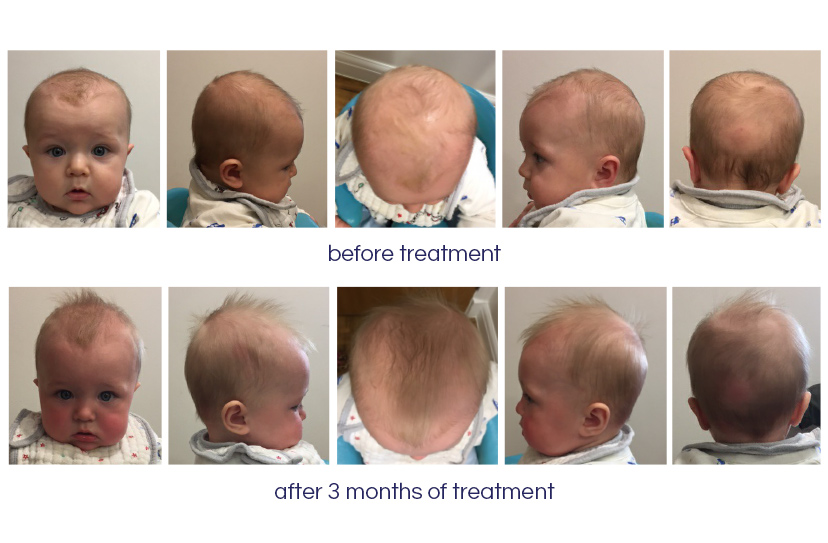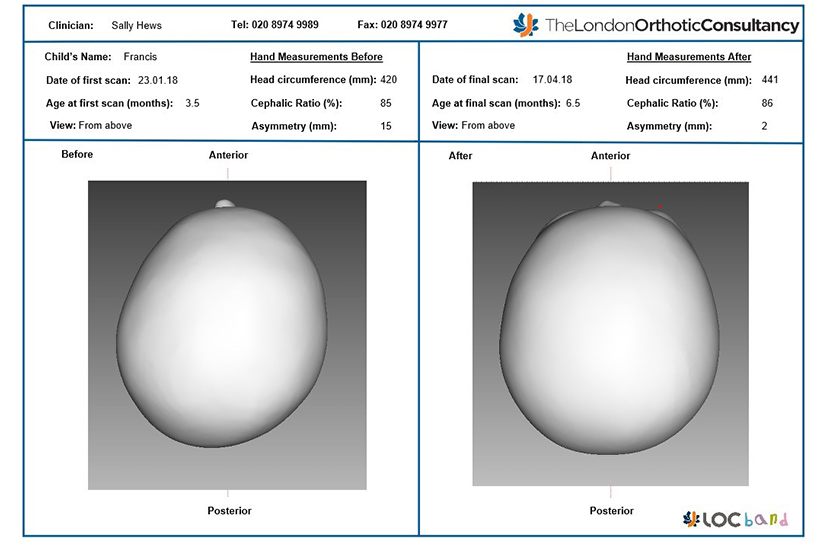
12 June 2018
We love being able to share success stories from helmet therapy. Senior orthotist Sally Hews talks to us about baby Francis’ plagiocephaly journey and what you can expect from flat head syndrome treatment at the London Orthotic Consultancy:
“Francis came to see me in Harley Street with his parents when he was almost 4 months old, his parents had noticed his flat head shape when he was 2 months and began repositioning him almost immediately. He favoured sleeping on his back turned to the right but not exclusively. At such a young age his head could easily be turned during sleeping as is recommended when doing repositioning, however, his parents did not see any improvement with his head shape. They were aware of cranial remoulding helmets and were quite relaxed about moving forward with treatment once his plagiocephaly was confirmed as severe. He had some flattening at the back of his head and also some facial asymmetry.

Once fitted with his LOCband Francis responded so well. He was very happy during his treatment and due to his young age, his head shape corrected very well and so quickly that he only needed to wear his LOCband for 3 months. Because his parents had repositioned him so much early on, his sleeping position was varied and there was no concern about regression after removing the LOCband. So after 3 months of wear, it was completely removed and parents were very pleased with the results. His parents were incredibly relaxed about the whole process, which I feel really helped and rubbed off on Francis. Great results all round!” (Sally Hews, Senior Orthotist)
Mother Megan was incredibly pleased with the results achieved; “We would be very happy for Francis to be included on the case histories page of your website. We are so pleased with the outcome of his treatment - I can only hope the images will give other parents confidence in the treatment where needed.”

Above: Before flat head syndrome treatment (left) and after three months of treatment (right); a reduction in asymmetry from 15mm to 2mm
If you are worried about your baby’s head shape, you can use our online flat head diagnosis form for a fast, free and confidential clinical opinion from one of our orthotists. Your first appointment, should you need one, is also free.
This is very much dependent on how fast your baby is growing. The faster the growth, the more frequently your baby will be seen so that the helmet can be adjusted. In general, reviews will happen at two to four-week intervals.
The price of treatment covers:
Yes - All babies that have completed their course of treatment with us have achieved a measurable improvement in head shape. However, you don’t have to take our word for it.
Recent independent research conducted by a University Hospital in Germany has endorsed the treatment for babies with moderate or severe plagiocephaly.
A larger, retrospective study has just been published that found complete correction was achieved in 94.4% of babies treated with helmet therapy.
The results were conclusive: repositioning achieved acceptable correction in 77.1% of cases, but 15.8% were moved onto helmet therapy because re-positioning was not working. Meanwhile, 94.4% of the infants who started in the helmet-treated group achieved full correction, as did 96.1% of those who were transferred from the repositioning group into the helmet-treated group.
Further information can be found on our Plagiocephaly Research page.
If your baby has a temperature or a fever due to illness you must remove the band. The band can be put back on once the temperature has returned to normal.
The optimum age for treatment is between four and seven months.
This is because the skull is most malleable at this age and improvements to head shape tend to take less time and are more dramatic. That is not to say that helmet therapy should be ruled out if the baby is older than seven months. Routinely, babies up to the age of 16 months can be treated very successfully.
The cut off age is around 18 months when the fontanelles (soft spots on the head) are no longer malleable. As babies grow and develop at different rates, it is always worth checking if you are not sure. There have been cases where a baby’s fontanelles have not fused yet by the age of 18 months, who have achieved successful, but less-marked results with cranial remoulding therapy.
Torticollis is a condition in which a tight or shortened muscle in one side of the neck causes the head to tilt or turn to one side, resulting in the infant resting its head in the same position. In 2013, we analysed the data from all first appointments in our Kingston clinic and found that 20% of the babies examined had some kind of neck condition that was causing head immobility.
The clinics and clinicians that provide this treatment in the UK will have received similar training and experience. However, we are the only clinic that manufactures its own helmet and our clinicians are closely involved with the process for each individual helmet that we produce.
In addition, we do not restrict review appointments to a set number, we are extremely flexible and respond to individual parents' needs so that the best outcome can be achieved for each baby.
The LOCband is non-invasive and works by applying gentle, constant pressure over the areas of the baby’s skull that are most prominent while allowing unrestricted growth over the flattened areas. The band consists of a soft foam layer inside a thermoplastic shell. As the baby grows, the band will be adjusted frequently to gently guide the skull into a more symmetrical shape.